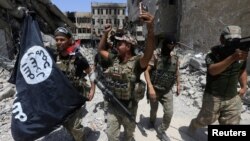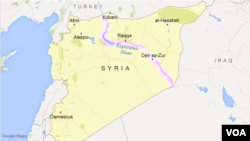Despite suffering what appear to be debilitating defeats on the ground in Iraq and parts of Syria, the Islamic State terror group is far from dead, according to military and intelligence officials from several countries that have long been tracking the threat.
Even on the ground in Iraq and parts of Syria, where anti-IS coalition officials believe the terror group’s fighting force, which once numbered in the tens of thousands, is down to less than 1,000 militants, top military officials remain wary.
“The war is not over,” U.S. Defense Secretary Jim Mattis told reporters at the Pentagon Friday. “The hunting down of these guys is not over.”
Coalition focus
For now, the focus of U.S. and coalition-backed forces is on an area of Syria known as the Middle Euphrates River Valley, an area that extends from the Syrian city of Raqqa to the Iraqi border, where many of the remaining fighters have sought refuge.
“We’re in the process of crushing the life out of the caliphate there, while trying to keep the innocent people safe,” Mattis said.
Yet military officials brush aside any notion that IS will collapse in one, ultimate death knell. As diminished as its force may be, the terror group has a history of biding its time, slowly gathering its strength until an opportunity to strike presents itself.
“ISIS will attempt to mount some form of insurgency,” the anti-IS coalition’s deputy commander for strategy and support, British Maj. Gen. Felix Gedney, told reporters from Baghdad this week, using an acronym for the terror group. “ISIS remains a threat in the region. It remains a threat to our homelands, as well.”
IS fighters seek safe haven
A key concern is the terror group’s knack for finding safe havens from which to operate.
In the case of IS fighters in Iraq and Syria, that has meant seeking refuge in parts of Syria under the control of President Bashar al-Assad and Russian-backed, pro-regime forces.
Coalition officials refuse to say just how many IS fighters have successfully fled to such areas, but they say those that do, seem to be able to move with impunity.
For now, U.S. officials are downplaying the danger, calling the flight of IS fighters “normal.”
“I’m not seeing right now that there’s some concentration where they’re going to come up big and have a safe haven,” Mattis said.
Yet intelligence officials say there are plenty of other places for the battle-hardened jihadists to go.
U.S. counterterror officials point to IS branches and even less formal networks in Turkey, Egypt and Libya as potential landing spots for IS fighters, in addition to more than a dozen other countries where they might find a home.
“ISIS has adapted to its more difficult circumstances by changing its operation model and it will continue to adapt,” the outgoing head of the U.S. National Counterterrorism Center, Nicholas Rasmussen, said earlier this month.
Afghanistan
One country where Islamic State’s resilience has been on display is Afghanistan.
Twice this year, the United States used airstrikes to kill the leader of the Islamic State’s so-called Khorasan province. And a third strike, in April, used the largest non-nuclear bomb in the U.S. arsenal to target a cave-and-tunnel complex in Nangarhar province.
But according to Afghan officials, since that time, IS-Khorasan has been reborn, growing from about 600 fighters to more than 3,000, thanks in part to an influx of foreign fighters from Pakistan and Uzbekistan.
Afghan officials have said they expect the size of the IS force to grow further, bolstered by fighters from Iraq and Syria, a concern shared by some in the West.
For the most part, there has been little evidence of a mass exodus of IS fighters from Iraq and Syria. While coalition officials believe many of the group’s leaders fled the battlefield at the earliest opportunity, they say there is little to suggest they have gone far.
Yet even if the flow of IS fighters from Iraq and Syria is best described as a trickle not a flood, there is ample reason to be concerned.
“The quality of the fighters after the experience on the ground in Iraq and Syria is something we’re paying very close attention to,” one U.S. counterterrorism official told VOA.
Returning foreign fighters
And the track record of IS foreign fighters who have returned, like those linked to the terror attacks in Paris and Brussels, show how lethal even a handful of returnees can be.
“Even if the numbers are small, they always have a disproportionate effect,” according to Lt. Gen. Michael Nagata, director of the Directorate of Strategic Operational Planning at National Counterterrorism Center.
“They bring leadership. They bring skill. They bring experience. And perhaps most importantly, they are totally committed,” Nagata said. “Two foreign fighters can have a strategic impact.”
That impact of returning foreign fighters is being felt across northern Africa and the Sahel, according to regional intelligence and counterterrorism officials.
“They know how to kill. They know how to use explosives,” Algeria’s Ambassador-Counselor for International Security Issues El Haouès Riache said during a recent visit to Washington. “They are ready for the worst.”
Riache said the knowledge IS operatives passed on to members of the Boko Haram terror group, active in Nigeria, Cameroon, Chad and Niger, has allowed that group to hang on, even under constant pressure.
“They learn from Daesh how to occupy territories, how to manage territories, how to collect taxes,” he said, using an Arabic acronym for IS. “They have implemented what they have learned.”
Need for cooperation
And despite a U.S.-backed campaign to eradicate IS in Libya, which at one time served as a base of operations for thousands of fighters, hundreds remain, taking advantage of an uneven regional and international response.
“This is a threat that is a transnational threat. You cannot fight it individually as Morocco, as Algeria or as Tunisia,” said Amb. Mohamed Salah Tamek with Morocco’s Penitentiary and Reintegration Administration. “We are not cooperating as far as security threats go.”
There are additional concerns that the collapse of the self-declared caliphate has not been enough to prevent IS fighters and operatives from communicating with each other. European counterterror officials say the terror group’s communications unit was continuing to function well after its Iraqi and Syrian capitals were liberated.
And in just the last week of December, IS has claimed attacks in St. Petersburg, Kabul, Cairo and the Sinai Peninsula while churning out a stream of propaganda calling for lone wolf attacks in the West.
“It’s a brand with diminishing appeal but the appeal is still there,” U.S. Defense Secretary Mattis told reporters Friday. But he expressed confidence that time and word of mouth would eventually undermine the terror group.
“They’ve lost a physical caliphate,” Mattis said. “It’s less inspirational, as the stories of what it’s like living under their rule come out.”













